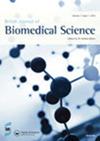案例报告:选什么的难题?囊性纤维化患者对伯克霍尔德氏菌的抗生素敏感性变异:对抗生素敏感性测试和治疗的影响
IF 2.7
4区 医学
Q2 MEDICAL LABORATORY TECHNOLOGY
引用次数: 0
摘要
在囊性纤维化微生物学中,当患者接受相同的抗生素治疗时,分离细菌病原体的抗生素敏感性结果与临床结果往往不匹配。造成这种情况的原因在很大程度上仍然难以捉摸。我们对一名成年囊性纤维化患者在 63 个月内连续分离出的细菌(n = 11)对四种抗生素(头孢他啶、美罗培南、米诺环素和三甲氧苄氨嘧啶-磺胺甲噁唑)的敏感性进行了测定。每个分离株都显示出自己独特的抗药性类型。根据临床和实验室标准研究所的方法和解释标准,第一个分离株对所有四种抗生素都敏感。四个月时首次检测到耐药性,显示出对头孢他啶和美罗培南的耐药性,以及对米诺环素和三甲双氨-磺胺甲噁唑的中等耐药性。18 个月时首次检测到泛耐药性(耐药型 IV),在此完全耐药型之前有三种耐药型(I、II 和 III)。在接下来的 45 个月中,该细菌继续表现出对抗生素的敏感性异质性,又出现了七种耐药型(耐药型 V-XI)。该细菌在 63 个月期间的相对抗药性指数显示,抗生素抗药性的发展与时间没有关系。采用多项式分布的数学模型表明,要有 78% 的把握捕捉到所有 11 种耐药菌型,就需要大量的菌落采样(大于 40 个/痰)。这种对大量菌落采样的要求与抗生素敏感性相关的方法学问题结合在一起,给生物医学科学实践带来了难题,即如何提供一种稳健的检测方法,既能捕捉抗生素敏感性变异,又能作为病理服务实用且具有成本效益,同时还能帮助临床医生为病人选择合适的抗生素。这项研究展示了伯克霍尔德氏菌抗生素敏感性检测的潜在变异性,代表了生物医学科学的进步。呼吸科医生和儿科医生需要让工作台的生物医学家了解这种变异,以便临床医生在为囊性纤维化患者选择合适的抗生素时,能够理解报告的药敏结果的意义。此外,还需要考虑在实验室报告中提供额外指导,以强调这种异质性,从而强调药敏结果与临床结果之间可能存在的错位。本文章由计算机程序翻译,如有差异,请以英文原文为准。
Case Report: The Conundrum of What to Pick? Antibiotic Susceptibility Variability in Burkholderia cenocepacia in Cystic Fibrosis: Implications for Antibiotic Susceptibility Testing and Treatment
Within cystic fibrosis microbiology, there is often mismatch between the antibiotic susceptibility result of an isolated bacterial pathogen and the clinical outcome, when the patient is treated with the same antibiotic. The reasoning for this remains largely elusive. Antibiotic susceptibility to four antibiotics (ceftazidime, meropenem, minocycline and trimethoprim-sulfamethoxazole) was determined in consecutive isolates (n = 11) from an adult cystic fibrosis patient, over a 63 month period. Each isolate displayed its own unique resistotype. The first isolate was sensitive to all four antibiotics, in accordance with Clinical and Laboratory Standards Institute methodology and interpretative criteria. Resistance was first detected at four months, showing resistance to ceftazidime and meropenen and intermediate resistance to minocycline and trimethoprim-sulfamethoxazole. Pan resistance was first detected at 18 months (resistotype IV), with three resistotypes (I, II and III) preceding this complete resistotype. The bacterium continued to display further antibiotic susceptibility heterogeneity for the next 45 months, with the description of an additional seven resistotypes (resistotypes V–XI). The Relative Resistance Index of this bacterium over the 63 month period showed no relationship between the development of antibiotic resistance and time. Adoption of mathematical modelling employing multinomial distribution demonstrated that large numbers of individual colony picks (>40/sputum), would be required to be 78% confident of capturing all 11 resistotypes present. Such a requirement for large numbers of colony picks combined with antibiotic susceptibility-related methodological problems creates a conundrum in biomedical science practice, in providing a robust assay that will capture antibiotic susceptibility variation, be pragmatic and cost-effective to deliver as a pathology service, but have the reliability to help clinicians select appropriate antibiotics for their patients. This study represents an advance in biomedical science as it demonstrates potential variability in antibiotic susceptibility testing with Burkholderia cenocepacia. Respiratory physicians and paediatricians need to be made aware of such variation by biomedical scientists at the bench, so that clinicians can contextualise the significance of the reported susceptibility result, when selecting appropriate antibiotics for their cystic fibrosis patient. Furthermore, consideration needs to be given in providing additional guidance on the laboratory report to highlight this heterogeneity to emphasise the potential for misalignment between susceptibility result and clinical outcome.
求助全文
通过发布文献求助,成功后即可免费获取论文全文。
去求助
来源期刊

British Journal of Biomedical Science
医学-医学实验技术
CiteScore
4.40
自引率
15.80%
发文量
29
审稿时长
>12 weeks
期刊介绍:
The British Journal of Biomedical Science is committed to publishing high quality original research that represents a clear advance in the practice of biomedical science, and reviews that summarise recent advances in the field of biomedical science. The overall aim of the Journal is to provide a platform for the dissemination of new and innovative information on the diagnosis and management of disease that is valuable to the practicing laboratory scientist.
 求助内容:
求助内容: 应助结果提醒方式:
应助结果提醒方式:


